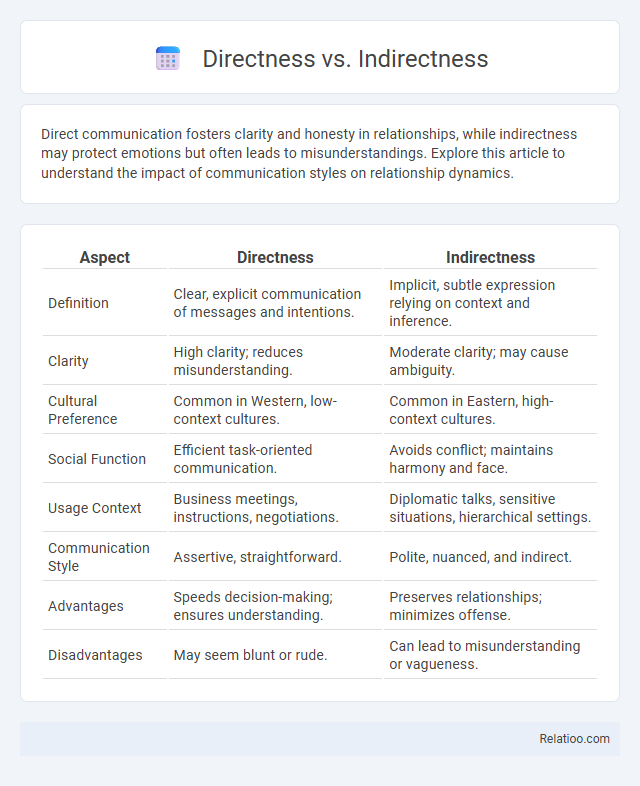Direct communication fosters clarity and honesty in relationships, while indirectness may protect emotions but often leads to misunderstandings. Explore this article to understand the impact of communication styles on relationship dynamics.
Table of Comparison
| Aspect | Directness | Indirectness |
|---|---|---|
| Definition | Clear, explicit communication of messages and intentions. | Implicit, subtle expression relying on context and inference. |
| Clarity | High clarity; reduces misunderstanding. | Moderate clarity; may cause ambiguity. |
| Cultural Preference | Common in Western, low-context cultures. | Common in Eastern, high-context cultures. |
| Social Function | Efficient task-oriented communication. | Avoids conflict; maintains harmony and face. |
| Usage Context | Business meetings, instructions, negotiations. | Diplomatic talks, sensitive situations, hierarchical settings. |
| Communication Style | Assertive, straightforward. | Polite, nuanced, and indirect. |
| Advantages | Speeds decision-making; ensures understanding. | Preserves relationships; minimizes offense. |
| Disadvantages | May seem blunt or rude. | Can lead to misunderstanding or vagueness. |
Understanding Directness and Indirectness
Understanding directness involves clear, straightforward communication where your message is explicit and unambiguous, often preferred in environments that value efficiency and transparency. Indirectness uses subtlety and implied meanings, relying on context and non-verbal cues to convey information, which can help maintain politeness and avoid confrontation. Choosing between directness and indirectness depends on cultural norms, social settings, and the desired impact of your communication.
Cultural Influences on Communication Styles
Cultural influences significantly shape communication styles, distinguishing directness, indirectness, and minimization approaches across societies. In cultures valuing explicit clarity, such as the United States or Germany, direct communication prevails to convey messages unambiguously. Conversely, collectivist societies like Japan or India often favor indirectness or minimization to preserve harmony, reduce conflict, and respect social hierarchies.
Key Traits of Direct Communication
Direct communication is characterized by clarity, straightforwardness, and explicit expression of ideas, ensuring your message is understood without ambiguity. Key traits include honest feedback, unambiguous language, and a focus on facts rather than emotions, which enhances efficiency in professional and personal interactions. This style minimizes misunderstandings by emphasizing transparency and concise information delivery.
Hallmarks of Indirect Communication
Indirect communication is characterized by subtle hints, context reliance, and non-verbal cues that convey meaning without explicit statements. Hallmarks include ambiguity, use of euphemisms, and a preference for preserving harmony and face-saving in social interactions. Understanding these nuances helps you interpret messages accurately while maintaining respectful and culturally sensitive dialogue.
Advantages of Being Direct
Being direct ensures clear and transparent communication, reducing misunderstandings and saving time. Your message is conveyed with confidence and precision, fostering trust and efficient decision-making. Directness enhances accountability by clearly defining expectations and responsibilities.
Benefits of Indirect Approaches
Indirect communication enhances relationship harmony by reducing the risk of offense and promoting social cohesion. This approach allows for subtlety and flexibility in conveying messages, enabling recipients to interpret meaning in a way that respects cultural norms and personal sensitivities. Minimization techniques within indirectness help mitigate conflict by softening criticism and fostering a collaborative environment.
Common Misunderstandings and Miscommunications
Directness, indirectness, and minimization in communication often lead to common misunderstandings due to differing cultural and contextual interpretations of intent. Your message may be misread if directness is seen as rudeness, indirectness perceived as evasiveness, or minimization mistaken for insincerity. Recognizing these variances helps prevent miscommunications that arise from conflicting expectations about clarity and politeness.
Navigating Directness vs Indirectness in the Workplace
Navigating directness vs indirectness in the workplace requires understanding cultural communication styles and individual preferences to foster effective collaboration and reduce misunderstandings. Emphasizing clear, respectful messages enhances productivity and minimizes conflict when balancing straightforward feedback with tactful language. Adapting communication strategies to context and audience promotes a positive work environment and strengthens team dynamics.
Tips for Balancing Both Styles
Balancing directness and indirectness requires understanding cultural context and communication goals to tailor messages effectively. Employ direct language for clarity and precision, while integrating indirect expressions to show politeness or reduce potential offense in sensitive situations. Use minimization techniques by softening statements to maintain harmony without sacrificing the message's core intent.
Choosing the Right Approach for Different Situations
Choosing the right communication approach depends on your audience and context; directness is effective for clarity and urgency, while indirectness suits sensitive topics requiring tact. Minimization helps soften negative messages, reducing potential conflict without obscuring the core information. Understanding cultural norms and the emotional state of your audience guides the balance between these styles to ensure your message is received appropriately and respectfully.

Infographic: Directness vs Indirectness
 relatioo.com
relatioo.com